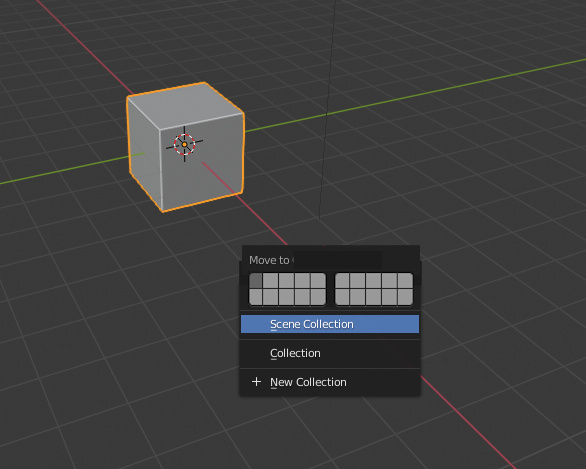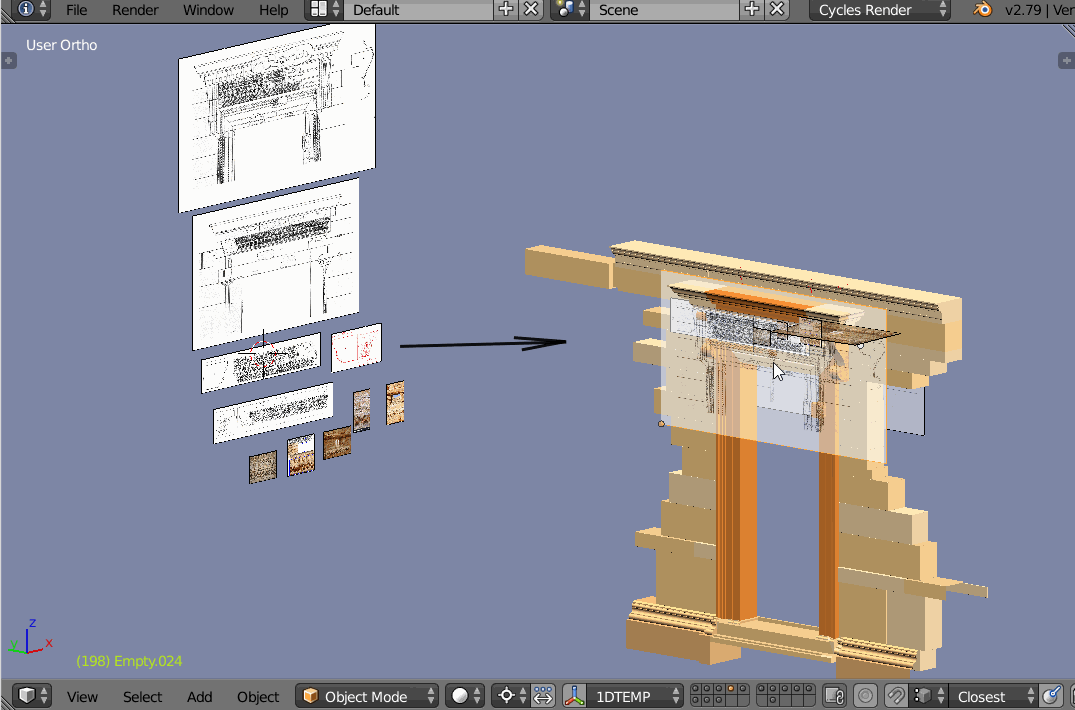I don’t like the idea to get the old layers back. It’s not visible what is in these things.
What is the purpose of the Master Collection?
I don’t like the idea to get the old layers back. It’s not visible what is in these things.
What is the purpose of the Master Collection?
It is not old layers, it is quick access QCD slots.
Master collection contains everything unsorted.
This system can provide possibility to handle and manage files with ~1000 collections.
Here are proposals about global visibility functions in outliner.
The way to provide control for heavyweight (~1000 collections) setups.
A) Normal state - initial state of outliner
B) Ability to use ctrl+LMB outliner isolation as toggle, with restoring previous global state.
First ctrl+LMB press remembers inital state of scene visibility, and isolates collection, second - restores previous state of scene, stored by firts ctrl+LMB.
This will allow to quickly figure out what is stored in any collection.
C) Ability to invert visibility - to figure out what is hidden in scene. Red line is drawn in UI.
D) Ability to swap any column with visibility. This will allow to view and edit render/other state of objects of entire scene as visibilty for better scene handling and control. Column, that was swapped with visibility column became purple.
E) Ability to make everything visible via single toggle hotkey (maybe * key), to make sure what it contains during setup.
Here is GIF:

Could not be bettter make that proposals in outliner GSOC thread?
Due to recent innovations, I made an analysis of solutions, that want to place in specific forums.
Can you tell me if it is clean or confusing?
Does it properly describes the problem we are feeling during workflow?
Can I post it?
Maybe it’s the impression it gives me, but you’ve been trying to show that the QCD is important for months. And I’m not sure it’s necessary to explain it, I think everyone knows it, including the developers.
Even though I’m interested in the subject, I get lost in the midst of so much text and ideas. You should perhaps summarize what you ask for in order to blender, which is what at least has not been clear to me.
And as I say, I think I’m agreeing with you and wanting a system of access and change of visibility layers as efficient as we had in 2.79
As shows latest development - actually, no.
In those pictures are shown problems, that causes thing was developed just recently.
So I am posting them now.
I have already written in the comments of developers.blender.org that the mistake they are making is trying to mix the two systems, which are totally two different things, one is a tree of collections of objects and the other is a layering of the 3d view.
So entire collections themselves can be in 3D view layers, that’s all.
If you hide collections or objects in the outiliner, this has global value, and they are simply hidden in all levels of the 3D view.
In fact, the objects in the 3d view, cannot be hidden, (the right definition is not to hide) they can only be moved from level to level and therefore objects are not hidden, but all the levels where we do not want the display of the objects that we have moved and that do not interest us they are simply layer deactivated.
It is now up to the dev to become aware of this, and restore the situation of the blender 2.7x layers because it was simply a winner idea. Without taking anything away from the new collections system.

There is also problem, that currently numer to send differs from number to invoke.
So you, basically, can’t select objects, press M5 to send, then 5 to invoke 5th slot.
It is needed to be fixed.
Also, continuing negotiations with developers about autonumeration types.
List was reduced to B-systems. Currently in 2.8 is B2 system, that turns to B3.
Result of analysis.
I like B2 was designed to work like B3 in complex scenes, I’ve seen peoples making empty default scene with 20 empty first-level collections to have B3 from the scratch.
Don’t know how to relate to this yet. I guess this is done intuitively in order to lower UMC rate.
— Preparing next post. Is it clean enough? :
Well, it seems, it is hard to explain the real need of QCD system without proper workflow example,
because it’s reason is related to UMC (User’s Memory Consumption) reducing, and does not exist out of context.
So, as it was told in Layers Maniphest, there are workflows, that requires QCD on top of collections more, than collections itself.
Let’s look at an average case, because simple ones have nothing to do with the topic.
Let’s look at the general process of building a scene using the example of historical restoration, which, as any other,
consists of two stages
An example of historical restoration is interesting because of its unusual attitude to references.
There are several groups of references quality, such as drawings and photoes.
As a result, the photos do not coincide with the drawings, and we are forced to use both types of sources together, comparing them during process.
This means that we must place all kinds of references on the model in order to be able to make it, in the end we get the following picture:
But here is an obvious problem - you know, it’s kind a mess)
Basically, to even start to make such a model you need such abitities:

And all this for only one element out of thousands!
So, making such kind of objects does not even need all that infinite amount of collections, it requires the fastest way of management of several numeric slots.
Actually, management of combinations of them!

Well
The QCD system solves that just perfectly - it allows to control huge amount of visibility combinations of slots at a glance!
So, what we have got for now:
_________A
Without QCD widget, managing all this things in outliner or that new “somewhere hidden or closing third of the screen” widget, it is impossible to finish the work without reading them in an amount the size of Tolstoy’s “War and peace”.
The work turns into a constant game of “find 20 differences from previous state you don’t see”.
Look how precisely you define the difference between this states because of human’s perception ability called subitizing:

This way abscence of QCD widget makes regular work incredibly hard.
_________B
Without numeric acces there is no way to control all that states at all!
(it was a VERY STRANGE proposal from devs to remove numeric keys assignment. Also it is already removed from edit mode, so now we have to quit it any time we need to manage visibility.)
_________C
As long as sending to slot number is not equal to invoke slot number (M5 issue), everything you sending with M5 shortcut goes to slot you can never guess because of those combinations mechanism!
Everything sent with the M5 is lost in the space-time combination paradigm!
Every management solution that was made in 2.8 makes you work with the only possible way - imperatively read and remember every time again and again,
raising levels of UMC to unprecedented heights.
read and remember to get involved to the scene
read and remember to send objects
read and remember to set states every time you trying to do so
read and remember to compare states
But human’s temporary memory is a very fragile thing - it’s hard to keep in mind even a couple of phone numbers for most people on earth.
So, even after a single day of such unnecessary reading and remembering and forgetting, human’s brain starts melting.
In such production like historic restoration, or architectural modeling, or gamedev asset making,
people need to make such operations with a maximum speed of their perception, to make thousands temporal setups and, probably billions comparisons.
At the moment you can forget about changing state 20 times per minute, it will damage your health.
That’s the cost of using systems with high UMC level.
And that’s needed to be fixed.
I think your workflow example really helps put things in perspective.
If a user is going to be working with a ton of different organized elements, as 3D artists often do, it really isn’t enough for everything to just be put in a list of collections and objects.
It’s essential to be able to rapidly change and combine complex visibility states, decoupled from high-level scene organization.
An artist should not have to spend so much of his brainpower just doing management of visibility states, but without a system like QCD to help, a huge amount of accumulated time and effort must be put toward this. It degrades the ability to perform the more important tasks of actually creating the 3D art.
I have an analogy:
A programmer may think of this issue like coding without intellisense/code-completion aids, or maybe even syntax highlighting. Those systems are there to ease the load on your brain, allowing you to save your brainpower for complex logic tasks and design, instead of using most of it just keeping menial information at the front of your mind.
Anyway, the concept of UMC is really important, and I appreciate your efforts to convey all this stuff. This is a very complex topic. You go very deep into it, and I think you make the advantages of QCD very clear here.
I will place that post at related topic in developer blender org.
A very nice example of UMC management by the way)
Everyday I use collections it just makes me mourn the death of layers even more. Then it’s like there are these weird advocates that are so zealous it’s important to them that I can’t have my “simple” thing. No, it has to be this thing where I’m super conscious about organization and I have to spend time and care and name things. I’m not trying to classify them, they don’t belong together, I don’t want them in a group. It’s so frustrating, and I think, “can I please just get this off my view for a second without worrying about it?” But no. There is some crazy war path where it’s so important that someone is “right” and the functionality is replaced you just have to do this and this and this and this instead of M+click, and it just makes me more frustrated and upset everyday. I can tell, it’s dead and it’s never going to change and it makes me sad and upset.
This M+click is called M5 issue.
We are fighting for it.
Just into the name of sanity.
What we lost was simplicity.
Ease of use in the context of a flow mindset.
We call this User’s Memory Consumption (UMC).
UMC reducing is a common task for the design of various systems.
hi, good to see activity around this important area.
We added a test collections manager here: https://developer.blender.org/T69577
Whilst not a full solution to the issues surrounding collections it’s something worth considering.
Hi!
Well, in short, if to speak in workflow problems, we need to speak in workflow terms, and it doesnot solves special workflow issues.
If to speak in terms of collection management out of special workflow context, we love the way it evolves)
Thank you for invitation!